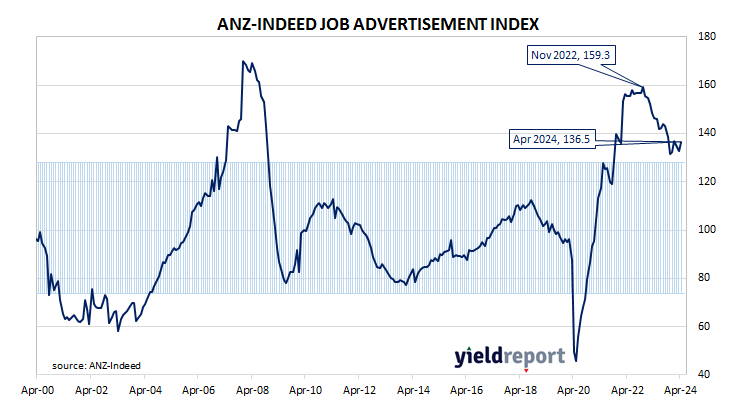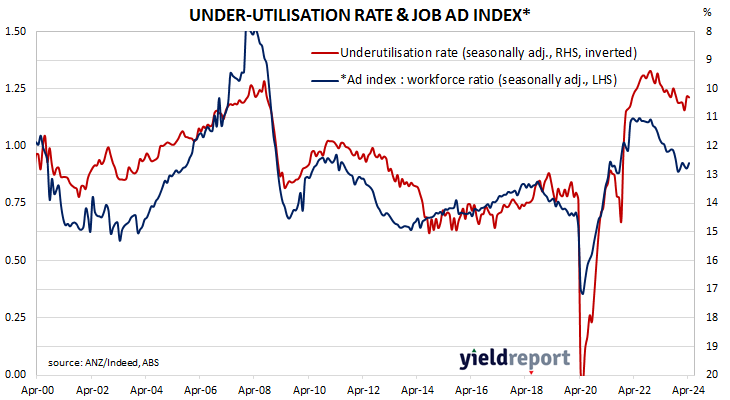Summary: Job ads up 2.8% in April; 6.6% lower than April 2023; ANZ: downward trend stalls; ACGB yields fall; rate-cut expectations sending mixed messages; ANZ: 78% of businesses in NAB’s business survey reported labour was constraint on output; ad index-to-workforce ratio rises.
From mid-2017 onwards, year-on-year growth rates in the total number of Australian job advertisements consistently exceeded 10%. That was until mid-2018 when the annual growth rate fell back markedly. 2019 was notable for its reduced employment advertising and this trend continued into the first quarter of 2020. Advertising then plunged in April and May of 2020 as pandemic restrictions took effect but recovered quite quickly, reaching historically-high levels in 2022.
According to the latest reading of the ANZ-Indeed Job Ads Index, total job advertisements in April increased by 2.8% on a seasonally adjusted basis. The index rose from 132.8 in March after revisions to 136.5, with the gain following a decline of 1.0% in March and loss of 1.8% in February. On a 12-month basis, total job advertisements were 6.6% lower than in April 2023, up from March’s figure of -10.6%.
“2023’s downward trend in ANZ-Indeed Job Ads has stalled in 2024, at least for now,” said ANZ economist Madeline Dunk. “The series has risen 3.9% since its recent trough in November last year, and the three-month moving average has been steady over the past few months.”
The update was released on the same day as the Melbourne Institute’s latest Inflation Gauge reading and Commonwealth Government bond yields declined again, although not quite as much as the falls of US Treasury yields on Friday night (AEST) and with not much movement at the short end.. By the close of business, the 3-year ACGB yield had slipped 1bp to 4.02% while 10-year and 20-year yields both finished 4bps lower at 4.39% and 4.69% respectively.
In the cash futures market, expectations regarding the cash rate changes over the next 12 months continued to send mixed messages. At the end of the day, contracts implied the cash rate would remain close to the current rate for the next few months and average 4.335% through May and 4.35% in June. However, November contracts implied a 4.42% average cash rate, February contracts implied 4.325%, while May 2025 contracts implied 4.22%.
“In Q1, 78% of businesses that responded to NAB’s business survey reported labour was a constraint on output,” Dunk added. “While this is down from the peak of 91% in Q3 2022, it is still well above the pre-pandemic average of 42% and aligns with what ANZ-Indeed Job Ads is telling us; that supply and demand imbalances in the labour market have yet to normalise.”
The inverse relationship between job advertisements and the unemployment rate has been quite strong (see below chart), although ANZ themselves called the relationship between the two series into question in early 2019.
A higher job advertisement index as a proportion of the labour force is suggestive of lower unemployment rates in the near future while a lower ratio suggests higher unemployment rates will follow. April’s ad index-to-workforce ratio rose from 0.90 to 0.92.
In 2008/2009, advertisements plummeted and Australia’s unemployment rate jumped from 4% to nearly 6% over a period of 15 months. When a more dramatic fall in advertisements took place in April 2020, the unemployment rate responded much more quickly.



